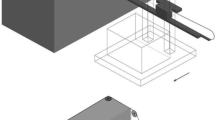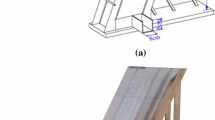Abstract
The paper is dealing with application of theoretical equations derived for rock disintegration onto materials with similar behavior—thick scales on hot metal rolling slabs. Penetration of water jet through a hot, rock-like material (e.g. scale) and work of the steam bubbles emerging from the water jet on the boundary between the scale layer and the hot metal material are described by a set of appropriate equations. The model is applied on the fan jets used for de-scaling process, and it provides both the qualitative and the quantitative results. These results make possible to determine the depth of penetration of water jet into the material of the scales and calculate the sizes of pieces of the disintegrated scales. Both mechanisms of water jet acting on scales, mechanical penetration to a certain depth in the material and the formation of steam bubbles inside the material, create mechanical stresses in the material of scales, especially the tensile and the shear ones. Pieces of scales are separated due to exceeding the limits of the stress and strain in the material of scales. The presented analytical equations describing the process in a simple way yield the quick and apprehensible calculation of applicable results. It is an alternative to solution of a rather complicated set of differential equations describing the mass and heat flow. The proposed theoretical base runs with technical factors and properties that can be obtained from tables or analogies with other materials or processes. The typical water pressure range of rolling mills is 16–24 MPa, the equivalent diameter of the applied water nozzle is 2 mm, the average traverse speed of the rolling slab is set to 1 m s−1, and the mean stand-off distance of the nozzle from the steel slab surface is 150 mm. Calculated depth of penetration into scales is ranging from 5 to 18 mm for these parameters, while the real thickness of scales lies between 1 and 7 mm. Simultaneously, the calculated length of the peeled layer in the direction of the jet movement ranges from 30 to 70 mm and the cutting width determined from the jet shape and the stand-off distance is 80–120 mm. Therefore, the calculated size of the scale debris is 30 × 80 mm for layers thicker than 5 mm and 70 × 120 mm for the ones thinner than 2 mm. These theoretical values correspond with sizes of real scale debris picked at the rolling mill.
Similar content being viewed by others
References
Leach SJ, Walker GL (1966) Some aspects of rock cutting by high speed water jets. Philos T R Soc A 260:295–310
Crow SC (1973) A theory of hydraulic rock cutting. Int J Rock Mech Min 10:567–584
Rehbinder G (1980) A theory about cutting rock with water jet. Rock Mech 12:247–257
Mellor M (1972) Some general relationships for idealized jet cutting. In: Proceedings of the 1st International Symposium on Jet Cutting Technology, BHRA, Coventry, England, paper A2, pp 25-36
Yanaida K (1974) Flow characteristics of water jets. In: Proceedings of the 2nd International Symposium on Jet Cutting Technology, BHRA, Cambridge, England, paper A2, pp 19-32
Mazurkiewicz M (1977) Some aspects of intensification of material machining by high-pressure water jet. Transactions of the Technological Institute of Machine Manufacturing at the Polytechnic in Wroclaw No. 19, Monograph series No. 2, Wroclaw, Poland
Hashish M, duPlessis MP (1978) Theoretical and experimental investigation of continuous jet penetration of solids. J Eng Ind - T ASME 100:88–94
Hashish M, duPlessis MP (1979) Prediction equation relating high velocity jet cutting performance to stand-off distance and multipasses. J Eng Ind - T ASME 101:311–318
Pasche E (1981) Das Schneidverhalten von Hochstdruck-wasserstrahlen zur Unterstutzung Mechanischer Loser-vorgange. Glückauf-Forschungshefte 42:32–38
Nikonov GP, Kuzmitch IA, Goldin JA (1986) Disintegration of rock materials by high-pressure water jets. Nedra, Moscow, USSR
Summers DA, Blaine JG (1994) A fundamental test for parameter evaluation. In: Rakowski Z (ed) Geomechanics 93. Rotterdam, Balkema, Netherlands, pp 321–325
Hlaváč L (1992) Physical description of high energy liquid jet interaction with material. In: Rakowski Z (ed) Geomechanics 91. Balkema, Rotterdam, pp 341–346
Hlaváč LM, Sochor T (1995) Modelling of rock excavation by high energy water jet. In: Rossmanith HP (ed) Mechanics of jointed and faulted rock. Balkema, Rotterdam, pp 847–852
Hlaváč LM (1998) JETCUT—software for prediction of high-energy waterjet efficiency. In: Louis H (ed) Jetting technology. Prof. Eng. Pub. Ltd., Bury St Edmunds & London, pp 25–37
Hlaváč LM (1999) Theoretical and experimental investigation of a high energy waterjet efficiency on thermally treated rocks. In: Hashish M (ed) Proceedings of the 10th American Waterjet Conference. WJTA, Houston, Texas, pp 497–506
Hlaváč LM, Hlaváčová IM, Kušnerová M, Mádr V (2001) Research of waterjet interaction with submerged rock materials. In: Hashish M (ed) Proceedings of the 2001 WJTA American Waterjet Conference. WJTA, St. Louis, Missouri, pp 617–624
Paul S, Hoogstrate AM, van Luttervelt CA, Kals HJJ (1998) Analytical and experimental modeling of abrasive water jet cutting of ductile materials. J Mater Process Tech 73:189–199
Chen FL, Wang J, Lemma E, Siores E (2003) Striation formation mechanisms on the jet cutting surface. J Mater Process Tech 141:213–218
Deam RT, Lemma E, Ahmed DH (2004) Modelling of the abrasive water jet cutting process. Wear 257:877–891
Orbanic H, Junkar M (2008) Analysis of striation formation mechanism in abrasive water jet cutting. Wear 265:821–830
Hlaváč LM (2009) Investigation of the abrasive water jet trajectory curvature inside the kerf. J Mater Process Tech 209:4154–4161
Srinivasu DS, Axinte DA, Shipway PH, Folkes J (2009) Influence of kinematic operating parameters on kerf geometry in abrasive waterjet machining of silicon carbide ceramics. Int J Mach Tool Manu 49:1077–1088
Hlaváč LM, Strnadel B, Kaličinský J, Gembalová L (2012) The model of product distortion in AWJ cutting. Int J Adv Manuf Tech 62:157–166
Kong MC, Anwar S, Billingham J, Axinte DA (2012) Mathematical modelling of abrasive waterjet footprints for arbitrarily moving jets: part I—single straight paths. Int J Mach Tool Manu 53:58–68
Anwar S, Axinte DA, Becker AA (2013) Finite element modelling of abrasive waterjet milled footprints. J Mater Process Tech 213:180–193
Anwar S, Axinte DA, Becker AA (2013) Finite element modelling of overlapping abrasive waterjet milled footprints. Wear 303:426–436
Billingham J, Miron CB, Axinte DA, Kong MC (2013) Mathematical modelling of abrasive waterjet footprints for arbitrarily moving jets: part II—overlapped single and multiple straight paths. Int J Mach Tool Manu 68:30–39
Kumar N, Shukla M (2012) Finite element analysis of multi-particle impact on erosion in abrasive water jet machining of titanium alloy. J Comput Appl Math 236:4600–4610
Narayanan C, Balz R, Weiss DA, Heiniger KC (2013) Modelling of abrasive particle energy in water jet machining. J Mater Process Tech 213:2201–2210
Aydin G, Karakutr I, Aydiner K (2012) Performance of abrasive waterjet in granite cutting: influence of the textural properties. J Mater Civil Eng 24:944–949
Karakutr I, Aydin G, Aydiner K (2012) An experimental study on the depth of cut of granite in abrasive waterjet cutting. Mater Manuf Process 27:538–544
Lu YY, Tang JR, Ge ZL, Xia BW, Liu Y (2013) Hard rock drilling technique with abrasive water jet assistance. Int J Rock Mech Min 60:47–56
Chillman A, Ramulu M, Hashish M (2010) Waterjet and water-air jet surface processing of a titanium alloy: a parametric evaluation. J Manuf Sci E-T ASME 132:Article Number 011012
Azhari A, Schindler C, Kerscher E (2012) Improving surface hardness of austenitic stainless steel using waterjet peening process. Int J Adv Manuf Tech 63:1035–1046
den Dunnen S, Kraaij G, Biskup C, Kerkhoffs GMMJ, Tuijthof GJM (2013) Pure waterjet drilling of articular bone: an in vitro feasibility study. Stroj Vestn-J Mech E 59:425–432
Moyo D, Anandjiwala RD (2013) Studies on waterjet impact forces in the hydroentanglement process. Text Res J 83:1717–1727
Ozcelik Y, Ciccu R, Bortolussi A (2013) Effect of working parameters on excavation rate and specific energy on surface treatment with pure water jet. J Test Eval 41:104–115
Sitek L., Bodnárová L, Válek J, Zeleňák M, Klich J, Foldyna J, Novotný M (2013) Effects of water jet on heat-affected concretes. In: Juozapaitis A, Vainiunas P, Zavadskas EK (eds) Modern building materials, structures and techniques, book series: Procedia Engineering 57:1036-1044
Vijay MM (1998) Design and development of a prototype pulsed waterjet machine for the removal of hard coatings. In: Louis H (ed) Proceedings 14th International Conference on Jetting Technology, BHR Group Conference Series Publication 32. Professional Engineering Publishing, London, pp 39–57
Foldyna J, Sitek L, Švehla B, Švehla S (2004) Utilization of ultrasound to enhance high-speed water jet effects. Ultrason Sonochem 11:131–137
Hlaváč LM, Bodnárová L, Janurová E, Sitek L (2012) Comparison of continuous and pulsing water jets for repair actions on road and bridge concrete. Balt J Road Bridge E 7:53–59
Dehkhoda S, Hood M (2013) An experimental study of surface and sub-surface damage in pulsed water-jet breakage of rocks. Int J Rock Mech Min 63:138–147
Bollaert EFR, Schleiss AJ (2005) Physically based model for evaluation of rock scour due to high-velocity jet impact. J Hydraul E 131:153–165
Lopatnikov SL, Gillespie JW, Morand C, Lumpkin R, Dignam J (2012) The new test method for high velocity water jet impact. Exp Mech 52:1475–1481
Hsu CY, Liang CC, Teng TL, Nguyen AT (2013) A numerical study on high-speed water jet impact. Ocean Eng 72:98–106
Shim YM, Sharma RN, Richards PJ (2013) Proper orthogonal decomposition analysis of the flow field in a plane jet. Exp Therm Fluid Sci 51:37–55
Author information
Authors and Affiliations
Corresponding author
Rights and permissions
About this article
Cite this article
Hlaváč, L.M. Application of water jet description on the de-scaling process. Int J Adv Manuf Technol 80, 721–735 (2015). https://doi.org/10.1007/s00170-015-7020-7
Received:
Accepted:
Published:
Issue Date:
DOI: https://doi.org/10.1007/s00170-015-7020-7




